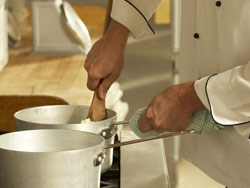


You’ll incorporate many of the cooking techniques you’ve mastered up to this point, preparing some delicious seafood dishes sure to impress your friends and family.
CULINARY FUNDAMENTALS BRAISE HOW TO
Week 4 – Fish: Living in New England, you’ve got to learn how to properly cook fish! Practice techniques of preparing fin fish, shellfish, and crustaceans. You’ll build complete dishes with pan sauces and sides. Take the angst out of cooking meat by learning how to properly prepare different cuts of beef, pork, and lamb following the best methods for each protein type and cut. Week 3 – Meat: No one wants under or overcooked meat. Practice your moist heat and dry heat cooking skills while turning chicken breasts, wings, and legs into novel dishes. Week 2 – Poultry: Buying a whole chicken is more economical than buying parts, so it’s time you learned some de-boning methods, dividing the whole chicken into workable parts. Learn the differences while preparing soups, salads, sides, and vegetarian entrées. Week 1 – Vegetables, Grains, and Beans: Some techniques are best suited for cooking spring/summer vegetables, while others are best for fall/winter vegetables. Learn additional techniques for preparing vegetables, chicken, meat, fish, and pasta and make it all come together in a complete meal sure to wow even the pickiest dinner guests. Applying the skills you’ve honed over the past five weeks, you’ll learn the secret to making a truly impressive dish.Īfter mastering some impressive skills and techniques in Techniques of Cooking I, you will want to take your abilities to the next level. Week 6 – Master Sauces: Nothing elevates good home cooking like a masterful sauce! This course will explore the classic mother sauces and their myriad of flavors, textures, and colors. Tackle recipes such as Ossobuco, braised short ribs, and rabbit fricassee. Utilize the stove top and oven to discover differences between techniques, and the benefits of using aromatic stocks. Week 5 – Moist Heat Cooking: Learn the braising, stewing, and poaching methods categorized as moist heat cooking. Possible recipes include skirt steak, grilled swordfish verde, and honey spiced pork. You’ll learn and practice with the cuts of meat best cooked by the dry heat method. Week 4 – Dry Heat Cooking: Discover the difference between radiant, conduction, and convection heat sources through roasting, grilling, and sautéing.

From these bases, you will make a variety of soups, like Southwest squash, fennel corn chowder, and vichyssoise. Start with the basics: beef, chicken, veal, and vegetable stocks. Week 3 – Soups and Stocks: A good stock is the foundation of all great cooking. Recipes may include hollandaise sauce, omelets, soufflés, and custards. Learn about the science of cooking an egg in many forms from whole to yolks and whites to foams.

Week 2 – Eggs: Did you know the 100 folds of a classic chefs’ toque are said to represent the many ways a chef can cook an egg. Learn how to select and sharpen knives, practice a variety of cuts, and work with uniquely shaped vegetables.
CULINARY FUNDAMENTALS BRAISE SERIES
Week 1 – Knife Skills: Kick off this in-depth series by slicing and dicing your way to culinary proficiency.


 0 kommentar(er)
0 kommentar(er)
